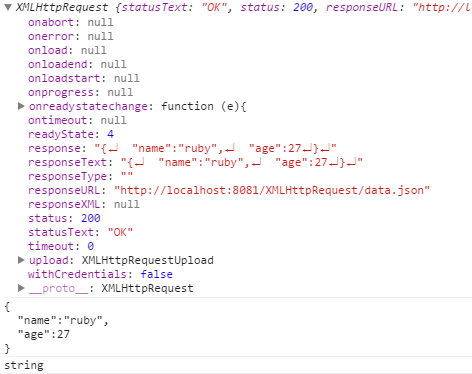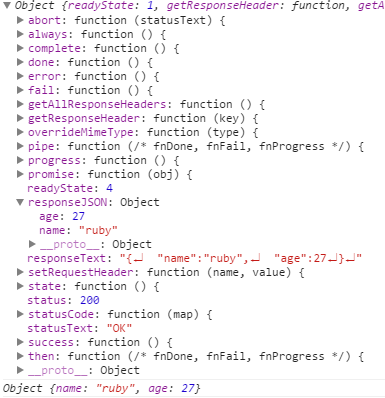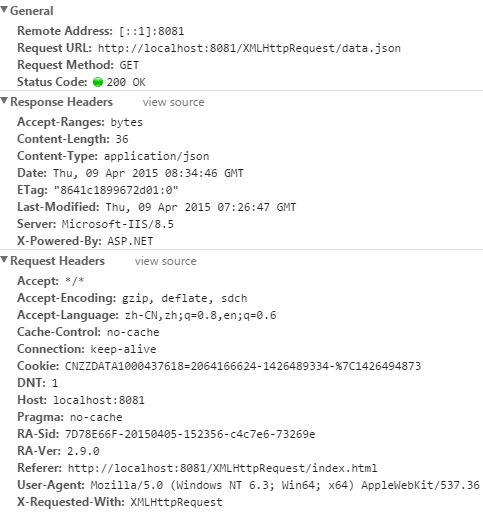写在前面:在学习XMLHttpRequest对象时碰到的一个问题,发现jquery的http请求会自动处理响应内容,变为开发者想要的数据,下面来看看吧:
实验案例:
var xhr=new XMLHttpRequest();xhr.onreadystatechange=function(e){console.log(e);if(xhr.readyState==4 && xhr.status==200){console.log(xhr);console.log(xhr.responseText);}}xhr.open('get','./data.json');xhr.send();
请求成功后的xhr:


response中已经有了数据,响应内容默认为字符串
responseType为'',也就是默认值
responseText中是响应主体的内容
responseURL指出了我们请求的资源路径
为什么返回的不是json对象?
上图中的信息:responseType是一个空字符串,也就是指明了返回的是一个字符串,而且从下面的log我们也可以看出来,为了清楚,我把xhr.responseText的类型也打印了出来,确实是string。
而如果我们换成下面的代码:
var xhr=$.ajax({url:'./data.json',success:function(data){console.log(data);}});console.log(xhr);
得到结果截图如下:

这个被jQuery改的面目全非的xmlhttprequest对象,先看一个左侧的属性,其中有一个responseJSON,这是jquery的实现,标准中是没有这个属性的,而它的responseText是字符串。所以success回调应该就是调的这个属性咯。看下请求,没有什么区别:Content-Type都是application/json ,其实我们再切到response标签看下,是一样的数据格式。所以是不是可以说原生获取json格式数据的话,值都是json字符串形式的值?
这里的jquery版本为1.11.2,查看源码可以发现:在ajax方法中定义的done方法内,有这么一句:
// Get response data 这里是得到相应的内容,本例就是"'{"username":"ruby","age":"18"}'"if ( responses ) {response = ajaxHandleResponses( s, jqXHR, responses );}// Convert no matter what (that way responseXXX fields are always set)response = ajaxConvert( s, response, jqXHR, isSuccess );
也就是说,在得到最终请求数据时,jquery会去做响应内容的自动转换,先来看ajaxHandleResponses方法,它用于返回响应内容:
function ajaxHandleResponses(s, jqXHR, responses) {var firstDataType, ct, finalDataType, type,contents = s.contents,dataTypes = s.dataTypes;// Remove auto dataType and get content-type in the processwhile (dataTypes[0] === "*") {dataTypes.shift();if (ct === undefined) {ct = s.mimeType || jqXHR.getResponseHeader("Content-Type");/*这里的s是使用ajax传入的参数转化而来的对象,用于存储前端开发人员发起该请求时对请求的一些设置和js默认对请求的设置,s.mimeType是使用overrideMIMEType时会被写入s的,其实也就是在ajax方法中我们指定的contentType,如果没有该属性,就是查找相应对象的Content-Type属性,而这个是肯定有值的,本例中ct='application/json',即获取到了响应报文中报头Content-Type的值*/}}// Check if we're dealing with a known content-typeif (ct) {for (type in contents) {/*contents是一个固定的对象,用于匹配各种类型的数据{html: /html/json: /json/script: /(?:java|ecma)script/xml: /xml/}*/if (contents[type] && contents[type].test(ct)) {dataTypes.unshift(type);/*这里我们显然是匹配到了json这一项,所以dataTypes中加上一项['json']*/break;}}}// Check to see if we have a response for the expected dataTypeif (dataTypes[0] in responses) {finalDataType = dataTypes[0];/*如果这个类型的数据在responses中正好有,那么就直接将最终类型定义为dataType中的这一项,本例中,dataTypes[0]为'json',但实际返回的响应是text。responses就是根据相应内容生成的响应对象,这里是"{text:"{"username":"ruby","age":"18"}"}".*/} else {// Try convertible dataTypesfor (type in responses) {if (!dataTypes[0] || s.converters[type + " " + dataTypes[0]]) {/*检测responses中的各个类型的值是否可以转换为我们想得到的类型, 本例中这里的type为'text',s.converters定义的是各种转换用到的函数,比如s.converters['text json']=JSON.parse。本例中这里是可以转换的。列出来吧:s.converters:{"text script": function( text ) {jQuery.globalEval( text );return text;},// Convert anything to text"* text": String,// Text to html (true = no transformation)"text html": true,// Evaluate text as a json expression"text json": jQuery.parseJSON,// Parse text as xml"text xml": jQuery.parseXML}*/finalDataType = type;break;}if (!firstDataType) {firstDataType = type;}}// Or just use first onefinalDataType = finalDataType || firstDataType;}// If we found a dataType// We add the dataType to the list if needed// and return the corresponding responseif (finalDataType) {if (finalDataType !== dataTypes[0]) {dataTypes.unshift(finalDataType);//完善s.dataTypes中的值,即完善响应数据的类型,此时为['text','json']}return responses[finalDataType];//最终返回responses['text']}}
再来看ajaxConvert方法:
/* Chain conversions given the request and the original response* Also sets the responseXXX fields on the jqXHR instance*/function ajaxConvert(s, response, jqXHR, isSuccess) {var conv2, current, conv, tmp, prev,converters = {},// Work with a copy of dataTypes in case we need to modify it for conversiondataTypes = s.dataTypes.slice();//数组copy这么写?不知道为啥~你知道的话还望不吝赐教~// Create converters map with lowercased keysif (dataTypes[1]) {for (conv in s.converters) {converters[conv.toLowerCase()] = s.converters[conv];//构造一个转换对象,内容是s.converters中的那些转换函数.}}current = dataTypes.shift();// Convert to each sequential dataTypewhile (current) {if (s.responseFields[current]) {jqXHR[s.responseFields[current]] = response;/*这里给jqXHR即jquery构造出来的XMLHttpRequest对象赋值,在本例中,它在此添加了两个属性,一个是responseText,一个是responseJson*/}// Apply the dataFilter if providedif (!prev && isSuccess && s.dataFilter) {response = s.dataFilter(response, s.dataType);}prev = current;current = dataTypes.shift();//记住第一个类型,再获取第二个类型,这里的prev为‘text’, current为'json'。if (current) {// There's only work to do if current dataType is non-autoif (current === "*") {current = prev;// Convert response if prev dataType is non-auto and differs from current} else if (prev !== "*" && prev !== current) {// Seek a direct converterconv = converters[prev + " " + current] || converters["* " + current];//看看是否有prev类转current类的转换方法// If none found, seek a pairif (!conv) {for (conv2 in converters) {// If conv2 outputs currenttmp = conv2.split(" ");if (tmp[1] === current) {// If prev can be converted to accepted inputconv = converters[prev + " " + tmp[0]] ||converters["* " + tmp[0]];if (conv) {// Condense equivalence convertersif (conv === true) {conv = converters[conv2];// Otherwise, insert the intermediate dataType} else if (converters[conv2] !== true) {current = tmp[0];dataTypes.unshift(tmp[1]);}break;}}}}// Apply converter (if not an equivalence)if (conv !== true) {// Unless errors are allowed to bubble, catch and return themif (conv && s["throws"]) {response = conv(response);} else {try {response = conv(response);//转换为我们想要的数据类型,截至此我们已经得到想要的json数据啦} catch (e) {return {state: "parsererror",error: conv ? e : "No conversion from " + prev + " to " + current};}}}}}}return {state: "success", data: response};}
上面基本根据当前案例进行代码解析,很多情况没有一一列出,感兴趣的童鞋可以通过打断点调试的方式来解析代码。